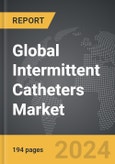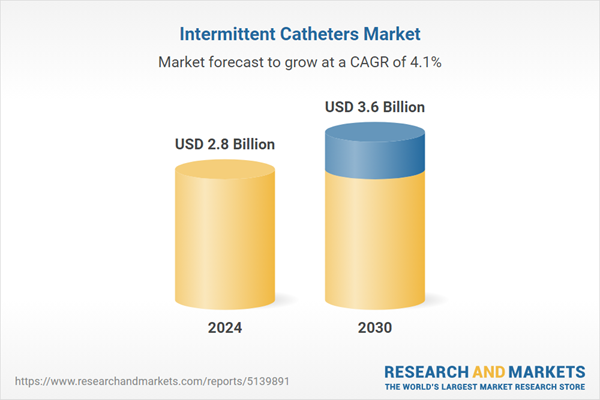The global market for Intermittent Catheters was valued at USD 2.8 Billion in 2024 and is projected to reach USD 3.6 Billion by 2030, growing at a CAGR of 4.1% from 2024 to 2030. This comprehensive report provides an in-depth analysis of market trends, drivers, and forecasts, helping you make informed business decisions.
Global Intermittent Catheters Market - Key Trends & Drivers Summarized
What Are Intermittent Catheters and Why Are They Crucial in Urological Care?
Intermittent catheters are medical devices used for the temporary drainage of urine from the bladder in individuals who cannot empty their bladder naturally. These catheters are crucial in urological care as they provide an effective solution for managing conditions such as urinary retention, neurogenic bladder, and spinal cord injuries. Unlike indwelling catheters, which remain in place for extended periods, intermittent catheters are inserted multiple times a day and removed after each use, reducing the risk of infections and complications. They are widely used in hospitals, long-term care facilities, and home care settings, offering patients greater control over their bladder management and improving their quality of life. As awareness of the benefits of intermittent catheterization grows, these devices are becoming an essential component of urological care for many patients.How Are Technological Advancements Shaping the Intermittent Catheters Market?
Technological advancements are significantly shaping the intermittent catheters market, particularly through innovations in materials, design, and user convenience. The development of advanced materials, such as hydrophilic coatings and silicone, is enhancing the comfort, safety, and ease of use of intermittent catheters, reducing the risk of urethral trauma and infections. Innovations in catheter design, including pre-lubricated and compact catheters, are making the devices more portable and discreet, improving patient compliance and convenience. The integration of user-friendly features, such as easy-to-open packaging and intuitive insertion aids, is further enhancing the usability of these devices, particularly for patients with limited dexterity. These technological trends are driving the adoption of intermittent catheters across healthcare settings, as they offer improved patient outcomes and align with the growing emphasis on patient-centered care.Why Is There an Increasing Demand for Intermittent Catheters in Healthcare?
The demand for intermittent catheters is increasing in healthcare due to the rising prevalence of urological conditions, aging populations, and the growing awareness of the benefits of intermittent catheterization. As the global population ages, the incidence of conditions such as urinary retention, neurogenic bladder, and spinal cord injuries is increasing, leading to a greater need for effective bladder management solutions. Intermittent catheters are also being increasingly recommended by healthcare providers as a safer alternative to indwelling catheters, particularly for long-term bladder management, as they reduce the risk of urinary tract infections (UTIs) and other complications. The growing awareness among patients about the benefits of intermittent catheterization, including greater independence and improved quality of life, is further driving demand. Additionally, the increasing focus on home healthcare and the need for cost-effective, patient-friendly medical devices are contributing to the expansion of the intermittent catheters market.What Factors Are Driving the Growth in the Intermittent Catheters Market?
The growth in the intermittent catheters market is driven by several factors related to demographic trends, technological advancements, and evolving healthcare practices. One of the primary drivers is the rising prevalence of urological conditions and the increasing demand for effective bladder management solutions, particularly among the aging population. Technological advancements in catheter materials and design, which enhance patient comfort, safety, and convenience, are also propelling market growth. The growing emphasis on reducing healthcare-associated infections, such as UTIs, is driving the adoption of intermittent catheters as a safer alternative to indwelling catheters. Additionally, the expansion of home healthcare services and the increasing focus on patient-centered care are contributing to the market's growth, as more patients seek convenient and effective solutions for managing their urological conditions at home. As these trends continue to shape the healthcare landscape, the intermittent catheters market is expected to experience sustained growth, driven by the need for safer, more comfortable, and user-friendly bladder management devices.Report Scope
The report analyzes the Intermittent Catheters market, presented in terms of market value (USD Thousand). The analysis covers the key segments and geographic regions outlined below.Segments
Indication (Urinary Incontinence, Spinal Cord Injuries, General Surgeries, Other Indications); Category (Female Length Catheters, Male Length Catheters, Kid Length Catheters); Product (Uncoated, Coated); End-Use (Hospitals, Ambulatory Surgery Centers, Medical Research Centers).Geographic Regions/Countries
World; United States; Canada; Japan; China; Europe (France; Germany; Italy; United Kingdom; and Rest of Europe); Asia-Pacific; Rest of World.Key Insights:
- Market Growth: Understand the significant growth trajectory of the Urinary Incontinence Indication segment, which is expected to reach $1.6 Billion by 2030 with a CAGR of a 4%. The Spinal Cord Injuries Indication segment is also set to grow at 5.2% CAGR over the analysis period.
- Regional Analysis: Gain insights into the U.S. market, valued at $761.2 Million in 2024, and China, forecasted to grow at an impressive 3.9% CAGR to reach $565.3 Million by 2030. Discover growth trends in other key regions, including Japan, Canada, Germany, and the Asia-Pacific.
Report Features:
- Comprehensive Market Data: Independent analysis of annual sales and market forecasts in USD from 2024 to 2030.
- In-Depth Regional Analysis: Detailed insights into key markets, including the U.S., China, Japan, Canada, Europe, Asia-Pacific, Latin America, Middle East, and Africa.
- Company Profiles: Coverage of major players such as Adapta Medical, Inc., B. Braun Melsungen AG, Becton, Dickinson and Company, Coloplast A/S, Cure Medical LLC and more.
- Complimentary Updates: Receive free report updates for one year to keep you informed of the latest market developments.
Why You Should Buy This Report:
- Detailed Market Analysis: Access a thorough analysis of the Global Intermittent Catheters Market, covering all major geographic regions and market segments.
- Competitive Insights: Get an overview of the competitive landscape, including the market presence of major players across different geographies.
- Future Trends and Drivers: Understand the key trends and drivers shaping the future of the Global Intermittent Catheters Market.
- Actionable Insights: Benefit from actionable insights that can help you identify new revenue opportunities and make strategic business decisions.
Key Questions Answered:
- How is the Global Intermittent Catheters Market expected to evolve by 2030?
- What are the main drivers and restraints affecting the market?
- Which market segments will grow the most over the forecast period?
- How will market shares for different regions and segments change by 2030?
- Who are the leading players in the market, and what are their prospects?
Some of the 41 major companies featured in this Intermittent Catheters market report include:
- Adapta Medical, Inc.
- B. Braun Melsungen AG
- Becton, Dickinson and Company
- Coloplast A/S
- Cure Medical LLC
- Hollister, Inc.
- Medical Technologies of Georgia, Inc.
- Pennine Healthcare Ltd.
- Teleflex, Inc.
Table of Contents
I. METHODOLOGYII. EXECUTIVE SUMMARY2. FOCUS ON SELECT PLAYERSIII. MARKET ANALYSISCANADAITALYREST OF EUROPEREST OF WORLDIV. COMPETITION
1. MARKET OVERVIEW
3. MARKET TRENDS & DRIVERS
4. GLOBAL MARKET PERSPECTIVE
UNITED STATES
JAPAN
CHINA
EUROPE
FRANCE
GERMANY
UNITED KINGDOM
ASIA-PACIFIC
Companies Mentioned (Partial List)
A selection of companies mentioned in this report includes, but is not limited to:
- Adapta Medical, Inc.
- B. Braun Melsungen AG
- Becton, Dickinson and Company
- Coloplast A/S
- Cure Medical LLC
- Hollister, Inc.
- Medical Technologies of Georgia, Inc.
- Pennine Healthcare Ltd.
- Teleflex, Inc.
Table Information
| Report Attribute | Details |
|---|---|
| No. of Pages | 194 |
| Published | February 2025 |
| Forecast Period | 2024 - 2030 |
| Estimated Market Value ( USD | $ 2.8 Billion |
| Forecasted Market Value ( USD | $ 3.6 Billion |
| Compound Annual Growth Rate | 4.1% |
| Regions Covered | Global |









